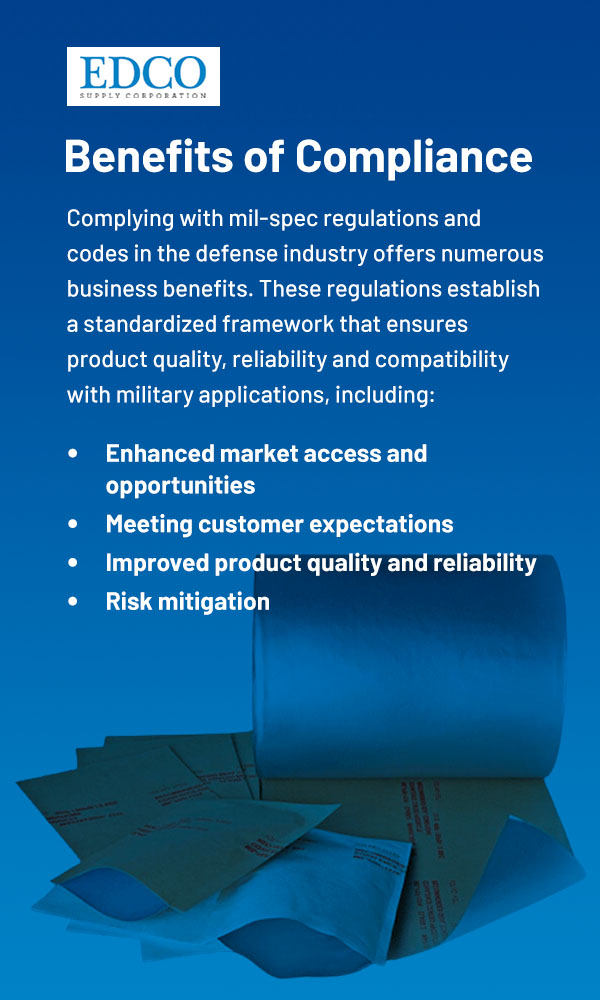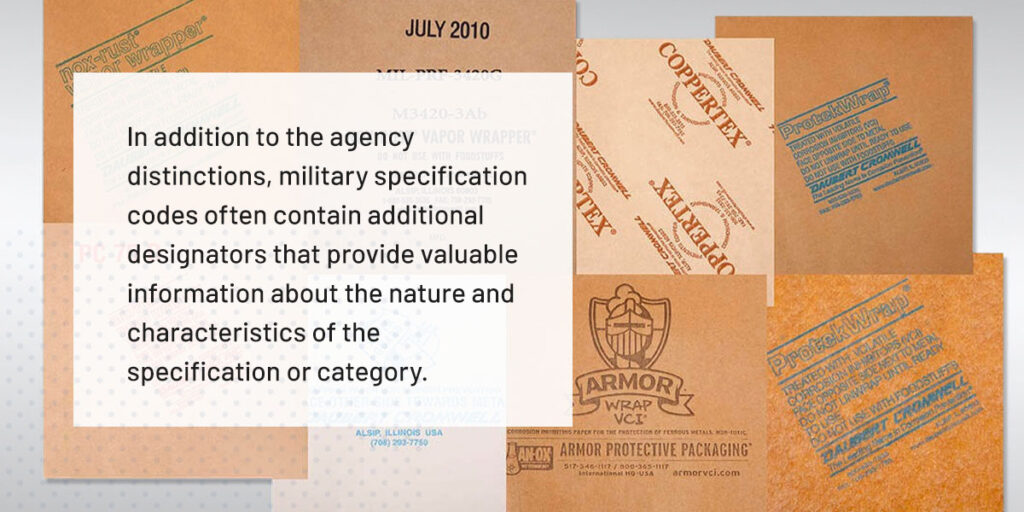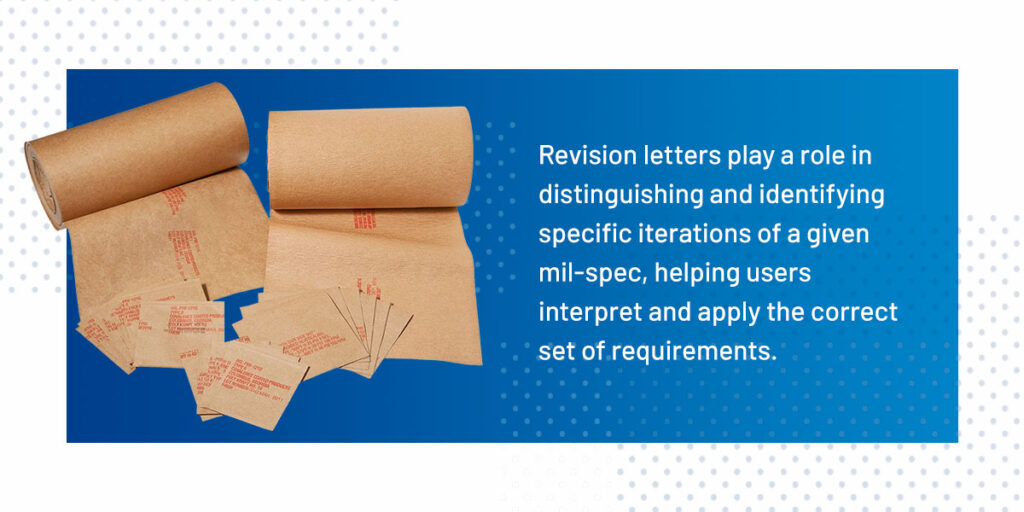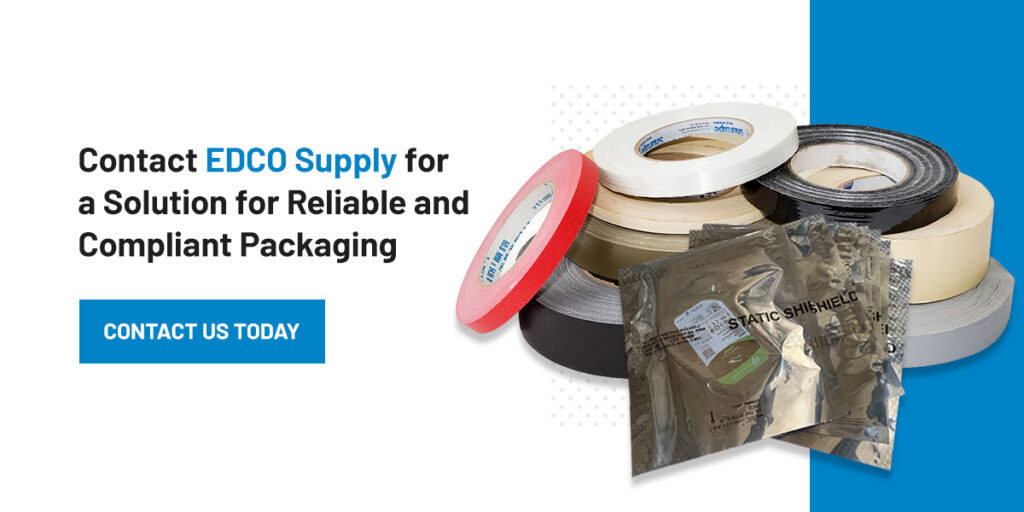Military specifications, or mil-spec, play a role in ensuring the quality, reliability and interoperability of products used by the military. These specifications outline the requirements, standards and guidelines contractors and suppliers must adhere to when developing, manufacturing and procuring items for military applications.
Understanding mil-spec packaging standards, regulations and codes is required for businesses operating within the defense industry or supplying goods to the military. The mil-spec regulations and codes guide serves as a valuable resource for understanding and interpreting the intricacies of military packaging requirements. This guide aims to demystify the complexities surrounding mil-spec requirements, enabling businesses to confidently navigate the regulations and ensure compliance with the strict standards set forth by the United States Department of Defense (DOD).
Mil-spec regulations cover a broad spectrum of areas that impact military procurement, from materials and manufacturing processes to packaging and labeling. They establish the performance, safety and compatibility criteria, ensuring that products meet the military’s unique demands and operational requirements.
The structure of mil-spec codes provides valuable information about the products, agencies involved, design requirements, specification numbers and revision history. By understanding the structure and significance of these codes, businesses can navigate the regulatory landscape effectively, identify applicable standards and ensure compliance with the latest revisions.
What Is Mil-Spec Packaging?
Military specifications are not mere suggestions but are the result of meticulous research, extensive testing and proven success in the field. The packaging is designed to safeguard items from various hazards, including extreme temperatures, humidity, moisture, vibration, shock and corrosion. By adhering to these stringent standards, suppliers can ensure that their products arrive at their destinations in pristine condition, ready to perform at peak efficiency.
Consider what mil-spec means for your packing:
- Durability: Materials used in mil-spec packaging must withstand the harshest conditions, including exposure to rough handling, stacking and transport over long distances. Heavy-duty corrugated fiberboard, wooden crates or metal containers are often employed to create robust packaging solutions that can withstand the rigors of military deployments.
- Efficiency and ease of handling: Packaging must facilitate quick and secure loading and unloading, enabling military personnel to access vital supplies swiftly during critical operations. Proper labeling and marking are also crucial to ensure accurate identification and tracking of packages, enabling efficient logistics management throughout the supply chain.
- Environmentally friendly materials and processes: While prioritizing protection and performance, mil-spec regulations also consider the environmental impact, promoting sustainability and responsible packaging practices.
Mil-spec packaging is not limited to specific types of items. It encompasses many products, including electronics, munitions, medical supplies and even perishable items such as food and pharmaceuticals. The regulations ensure that packaging is tailored to the unique requirements of each item, safeguarding its integrity and performance.
Suppliers and manufacturers are committed to delivering top-notch quality, reliability and safety by adhering to mil-spec packaging regulations. Military personnel can rest assured that their supplies are protected by packaging solutions that have undergone rigorous testing and meet the highest standards.
Understanding the Military Specification Code Structure
The intricate world of codes and regulations can often seem like a labyrinth, leaving many bewildered and perplexed about what military grade means. By grasping the underlying principles of the military specification code structure, you will gain an understanding of the precision, standardization and quality that lies at the heart of military operations.

Benefits of Compliance
Complying with mil-spec regulations and codes in the defense industry offers numerous business benefits. These regulations establish a standardized framework that ensures product quality, reliability and compatibility with military applications, including:
- Enhanced market access and opportunities: By adhering to mil-spec regulations, businesses gain access to a broader market, including government agencies, military contractors and other defense industry stakeholders. Compliance builds trust and confidence in your products, making securing contracts and partnerships in the defense sector easier.
- Meeting customer expectations: Compliance with mil-spec regulations demonstrates your commitment to meeting these expectations, leading to increased customer satisfaction and loyalty. It positions your business as a reliable and trusted supplier.
- Improved product quality and reliability: Mil-spec regulations outline stringent requirements for materials, manufacturing processes, performance and testing. By complying with these standards, businesses must adopt robust quality control measures, resulting in improved product quality and reliability.
- Risk mitigation: Non-compliance with mil-spec regulations can result in significant risks, such as contract cancellations, financial penalties, damaged reputation and even legal consequences. By proactively ensuring compliance, businesses mitigate these risks, safeguard their interests and maintain a strong position in the market.
Military Specification Agency Distinctions
These agency designations determine the applicable codes and regulations that govern protective packaging products. The initial portion of a military specification code provides insight into the category to which a protective packaging product belongs. This code identifies the specific agency under the DOD responsible for overseeing the product’s compliance with the relevant codes and regulations.
Various abbreviations are used to denote the agencies associated with military specifications. Here are a few examples:
- AN — Department of the Air Force and Navy
- FF — Federal Specification
- GSA — General Services Administration
- MIL — Military Specification
- MS — Military Standard
- NAS — National Aerospace Standard
- NSN — National Stock Number
It is important to note that each agency abbreviation has its own unique set of standards and specifications. These standards are meticulously crafted to ensure the highest quality, performance and compatibility with military operations.
In addition to the codes associated with government agencies, some codes pertain to external organizations collaborating with the military and influencing the specification standards. Some examples include:
- ANSI — American National Standards Institute
- ASME — American Society of Mechanical Engineers
- ASTM — American Society for Testing and Materials
- BA — Boeing Standard
- SAE — Society of Automotive Engineers
These external organizations bring their expertise to the table, contributing to developing industry-leading standards that align with the needs of the military.
For companies like Edco Supply Corporation, which provide military specification products, most of the codes will begin with “MIL.” For instance:
- MIL-D-3464E — Desiccants
- MIL-DTL-22020E — (Volatile Corrosion Inhibitors (VCI)
- ASTM D5486 PPP-T-76 — Pressure sensitive tapes, specifically Paper Carton Sealing Tape
When an external agency is involved, such as ASTM in the example above, the mil-spec code structure may differ slightly, reflecting that organization’s specific guidelines and requirements.
By comprehending the agency distinctions embedded within military specification codes, suppliers and manufacturers can ensure adherence to the appropriate standards and regulations, providing the military with packaging solutions that meet the demands of their operations. This knowledge empowers industry professionals to navigate military specifications with precision and confidence.

Mil-Spec Designators
In addition to the agency distinctions, military specification codes often contain additional designators that provide valuable information about the nature and characteristics of the specification or category. These designators offer insights into the specific purpose and requirements associated with the military specification. Here is a mil-spec code breakdown for easy use:
- MIL-SPEC: Defense Specification: The “MIL-SPEC” designator denotes a defense specification. This indicates that the specification outlines the detailed requirements and standards for a particular product or material intended for military use. It encompasses various criteria, including performance, materials, dimensions and testing methodologies.
- MIL-STD: Defense Standard: The “MIL-STD” designator represents a defense standard. Unlike specifications, standards provide guidelines, practices and procedures that establish uniformity, compatibility and interoperability across military systems and operations. MIL-STDs often cover design, development, production, testing and maintenance of military equipment.
- MIL-PRF: Performance Specification: The “MIL-PRF” designator signifies a performance specification. This type of specification focuses on the mil-spec definition of a product or material’s desired performance characteristics and requirements. MIL-PRF specifications emphasize the measurable outcomes and functional capabilities that the product should exhibit, ensuring it meets the demanding needs of military applications.
- MIL-DTL: Detail specifications: Provides in-depth information regarding design features, materials, manufacturing processes and quality control requirements for a specific product or material. They outline the precise parameters and tolerances that must be met to ensure consistency and reliability in military applications.
When working with Edco, you may come across specifications such as:
- MIL-D-3464E: Detail Specification: MIL-D-3464E specification defines the design features and specifications of the product, aligning them with the standards outlined by the DoD. MIL-D-3464E sets the requirements for desiccants, ensuring their effectiveness in controlling moisture and preserving the integrity of sensitive military equipment and supplies.
- MIL-DTL-22020E: Detail Specification: MIL-DTL-22020E indicates that the product’s design features and specifications comply with the standards specified by the DOD. In this case, MIL-DTL-22020E pertains to VCI, which protects against corrosion for critical military assets.
In contrast, we also have:
- MIL-PRF-81705D: Performance Specification: This indicates that the product’s performance and results comply with the military standards the DOD sets. Specifically, MIL-PRF-81705D relates to barrier bags or rolls, which provide effective electrostatic discharge protection for sensitive mil-spec code components during storage and transportation.
By deciphering the mil-spec meaning of these designators, suppliers, manufacturers and professionals involved in military procurement gain valuable insights into the specific requirements and expectations associated with each specification.
Mil-Spec Specification Numbers
The specification numbers or identifiers uniquely identify and categorize specific specifications within the corresponding designator category within the military specification framework. They are the difference between mil-spec and commercial products. These numbers serve as markers that represent distinct sets of requirements, guidelines or standards.
Once the agency and further code specifications are established, the specification numbers provide a specific identifier for the individual specification within the given designator category. Each specification number corresponds to a unique set of requirements and standards that must be followed to achieve compliance and meet the needs of military applications.
For instance, consider the example of MIL-STD-130, which outlines guidelines for marking items sold to the DOD. The “MIL-STD” designator indicates that it is a defense standard and the specification number “130” refers to this specific set of guidelines. MIL-STD-130 provides detailed instructions and requirements for marking items with unique identification mil-spec labels, ensuring efficient tracking, inventory management and traceability throughout the supply chain.
Another example is MIL-D-3464E, which pertains to the specification for desiccant bags. In this case, the “MIL-D” designator denotes a detailed specification. In contrast, the specification number “3464E” represents the precise set of requirements that desiccant bags must meet to be considered mil-spec compliant. MIL-D-3464E outlines the specific materials, dimensions, performance characteristics and other specifications that desiccant bags must adhere to, ensuring their effectiveness in controlling moisture and protecting sensitive military equipment and supplies.
These specification numbers serve as reference points and enable clear communication and understanding among suppliers, manufacturers and procurement personnel. They help ensure consistency, quality and reliability across different products, materials and systems within the military sector.

Mil-Spec Revision Letters
Completing the comprehensive understanding of mil-spec packaging codes is considering the revision letter. The final component denotes the version or edition of the standard being referenced. Revision letters play a role in distinguishing and identifying specific iterations of a given mil-spec, helping users interpret and apply the correct set of requirements. Additionally, these letters aid in recognizing outdated standards and promote the adoption of the most up-to-date versions for compliance.
Some mil-spec codes, such as MIL-D-3464E, feature a letter appended to the end of the specification number. This letter signifies the specific version or revision of the standard being referred to. One can visualize the core specification, like MIL-D-3464, as a foundational document with subsequent “amendments” or “additions” attached to it.
By incorporating revision letters, the mil-spec framework allows for evolving and refining standards over time. As technology advances, requirements may change, necessitating updates to ensure the highest level of performance, safety and interoperability. The revision letter acts as a roadmap, guiding users toward the standard’s most recent and relevant edition.
Another essential function of revision letters is to highlight outdated standards. As newer versions are released, older editions may become obsolete due to improvements, regulation changes or updated industry practices.
Recognizing the importance of revision letters, suppliers, manufacturers and procurement professionals prioritize staying informed about the latest revisions. This ensures that the products, materials and systems they provide or acquire meet the current mil-spec standards and requirements. By combining everything above, you’ll learn how to read mil-spec codes.
Additional Examples of Military Specification Codes
MIL-STD-310
MIL-STD-310 are test methods used for the evaluation of materials used in military packaging applications. This is crucial because not all items that the military receives will be used immediately. When these products are stored for long periods of time, in different climates, the packaging needs to be able to protect them during this time. These tests indicate 15 test method standards that are required to support the testing of materials used in packaging. There are a variety of factors that are considered, such as thickness, corrosiveness, water resistance, and even how easily the package can be punctured.
MIL-STD-2073
MIL-STD-2073 is applied when an item is entered into the military distribution system. This rule identifies methods of preservation to protect against physical and mechanical damage, environmentally induced deterioration, and other forms of degradation during storage. This is important because these damages can be easily prevented, but if they’re not, the product may malfunction. For example, VCI paper is treated with engineered chemicals that prevent salt, dirt, and oxygen from depositing on any protected metal. This means that VCI paper can be used to protect against corrosion.
MIL-STD-2070
MIL-STD-2070 is concerned about military preservation, which can be done by processes such as cleaning, drying, wrapping/cushioning, unit packing, and identifying. There are also different types of military preservation, which includes physical protection, preservation coating only, waterproof protection, water vapor proof protection, and water vaper proof protection with desiccant packs.
Contact EDCO Supply for a Solution for Reliable and Compliant Packaging
Navigating DOD codes and regulations can be challenging and time-consuming. That’s why Edco is here to simplify the process for you. As a trusted mil-spec materials supplier, we are well-versed in the various mil-spec requirements and packaging methods applicable to our products. We provide clear material specifications and packaging instructions aligned with DOD codes for every product, ensuring your team can easily maintain compliance.
Ensuring the utmost quality and compliance is our top priority. With every order we ship, our dedicated team conducts thorough inspections to guarantee that our products meet the highest standards before they reach your facility. As a family-owned business proudly manufacturing and distributing products in the United States, we take great pride in our work. We are committed to delivering exceptional service to our valued customers.
Partner with Edco to streamline your compliance process and gain peace of mind knowing your military specification packaging needs are expertly addressed. Trust us to provide you with reliable, high-quality packaging solutions that meet the stringent requirements of the military and other specialized industries.
Contact us today and discover how Edco Supply Corporation can support your operations with our extensive range of military specification products and unrivaled expertise.




